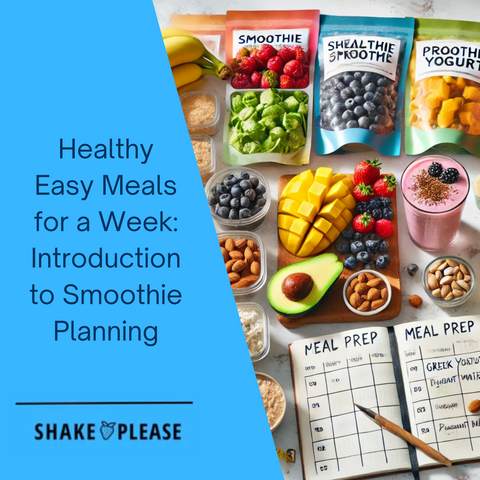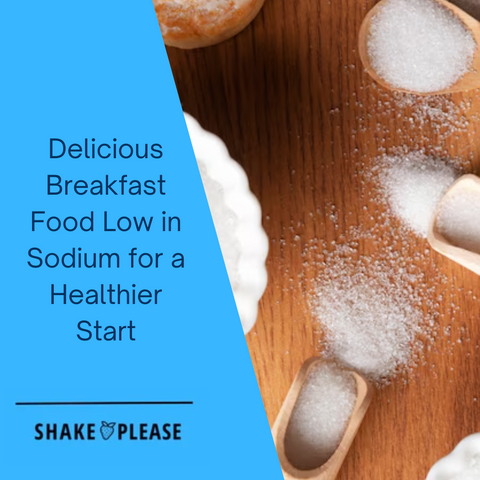
Planning your smoothies in advance is a simple yet effective way to stay on track with your health goals while saving time and effort. Whether you're looking to boost your nutrient intake, support weight management, or simply enjoy a quick and delicious meal, a well-thought-out smoothie routine can make all the difference. By incorporating a variety of fresh ingredients and prepping ahead, you can create flavorful, balanced smoothies that keep you energized throughout the week.
Benefits of Planning Your Smoothies Ahead
-
Supports weight management with nutrient-packed, low-calorie options – Pre-planned smoothies help you control portion sizes and avoid unhealthy snack choices, keeping your diet balanced.
-
Saves time and money by reducing daily prep and minimizing waste – Buying ingredients in bulk and prepping ahead eliminates the hassle of daily chopping and blending while preventing food spoilage.
-
Helps incorporate more fruits, vegetables, and superfoods into your diet – A structured plan ensures you get a variety of nutrients, including fiber, vitamins, and antioxidants, with every sip.
-
Keeps your smoothie routine exciting with diverse flavor combinations – Planning ahead allows you to experiment with different ingredients, preventing boredom and keeping your meals enjoyable.
Tips for Successful Smoothie Planning
-
Choose seasonal, fresh, and local produce for the best taste and nutrition – Seasonal fruits and vegetables are not only more flavorful but also more affordable and nutrient-dense.
-
Consider dietary needs—whether you're vegan, dairy-free, or keto – Tailor your smoothies to fit your dietary preferences by selecting appropriate ingredients like plant-based milk, low-carb fruits, or high-protein add-ins.
-
Create a detailed grocery list and stick to it for efficient shopping – Listing out your ingredients beforehand ensures you buy only what you need, avoiding impulse purchases and reducing food waste.
-
Prep smoothie packs in advance by portioning ingredients into freezer bags – Pre-measuring fruits, greens, and add-ins in individual bags or containers makes it easy to grab, blend, and go without extra hassle.
Benefits of Meal Planning
-
Save Time and Money
Meal planning helps you save time by allowing you to prepare meals in advance, reducing the need for last-minute takeout or fast food. It also helps you save money by enabling you to buy ingredients in bulk and avoid food waste. With a meal plan, you can create a grocery list and stick to it, avoiding impulse purchases and reducing your overall grocery bill.
-
Reduce Food Waste
Meal planning helps reduce food waste by allowing you to plan meals around ingredients that are approaching their expiration dates. You can also use up leftovers in creative ways, reducing the amount of food that ends up in the trash. By planning your meals, you can ensure that you use up all the ingredients you buy, reducing food waste and saving money.
-
Eat Healthier
Meal planning enables you to eat healthier by allowing you to plan meals that are balanced and nutritious. You can choose ingredients that are high in nutrients and low in calories, ensuring that you and your family are getting the nutrients you need to stay healthy. With a meal plan, you can also avoid relying on processed and packaged foods, which are often high in unhealthy ingredients.
Setting Up Your Smoothie Planning System
Creating a smoothie planning system ensures you have everything you need for a week of quick, nutritious meals. By organizing your grocery list and stocking up on essential ingredients, you can streamline your routine and make healthy choices effortlessly. Setting up a meal plan is easy and straightforward. Here are some steps to follow:
Determine Your Dietary Needs and Preferences
The first step in setting up a meal plan is to determine your dietary needs and preferences. Consider any dietary restrictions you may have, such as gluten-free or vegan, and think about the types of foods you enjoy eating. You should also consider your lifestyle and schedule, including your work hours and any social commitments you may have.
Once you have determined your dietary needs and preferences, you can start planning your meals. You can use a meal planning app or website, or simply create a spreadsheet or calendar to plan out your meals. Be sure to include a variety of healthy and delicious meals, and consider using leftovers to reduce food waste.
By following these steps, you can create a meal plan that is tailored to your needs and preferences, and that helps you save time and money, reduce food waste, and eat healthier.
Grocery List for a Week of Healthy Meals and Smoothies
Pantry Staples for Smoothie Boosts
-
Chia seeds – Rich in fiber, omega-3s, and protein for added nutrition and thickness.
-
Flax seeds – Great for digestion and a source of healthy fats.
-
Almond butter or peanut butter – Provides protein, healthy fats, and a creamy texture.
-
Plant-based or whey protein powder – Ideal for muscle recovery and meal replacement smoothies.
-
Honey or maple syrup (natural sweeteners) – Adds a touch of sweetness without refined sugar.
Fresh Produce for Vibrant Smoothies
-
Spinach or kale – Nutrient-dense greens that blend well and add vitamins.
-
Bananas – A natural sweetener that also creates a creamy texture.
-
Berries (strawberries, blueberries, raspberries) – Packed with antioxidants and natural sweetness.
-
Mangoes and pineapples – Tropical fruits that provide vitamin C and a bright, refreshing taste.
-
Avocados – Add creaminess and healthy fats for a filling smoothie.
Proteins and Dairy Alternatives
-
Greek yogurt or plant-based yogurt – Boosts protein and probiotics for gut health.
-
Almond milk, oat milk, or coconut water – Light and hydrating liquid bases.
-
Cottage cheese (for a creamy, high-protein texture) – A surprising but effective ingredient for thickness.
-
Tofu or silken tofu (for a vegan protein boost) – Adds plant-based protein and a silky texture.
With this system in place, you can easily mix and match ingredients to create delicious, balanced smoothies throughout the week.
Are Smoothies Filling? The Truth Revealed
Smoothie Ideas for the Week
-
Monday: Energizing Green Smoothie – Spinach, banana, almond milk, chia seeds, and a scoop of vanilla protein powder.
-
Tuesday: Tropical Bliss Smoothie – Mango, pineapple, coconut water, and Greek yogurt for a creamy texture.
-
Wednesday: Berry Antioxidant Smoothie – Mixed berries, banana, flax seeds, and almond milk.
-
Thursday: Creamy Avocado Banana Smoothie – Avocado, banana, almond butter, spinach, and oat milk.
-
Friday: Chocolate Peanut Butter Protein Smoothie – Cocoa powder, banana, peanut butter, and a scoop of chocolate protein powder. Try Chocolate Peanut Butter Banana Protein Smoothie for a quick option!
-
Saturday: Pineapple Berry Detox Smoothie – Pineapple, mixed berries, spinach, chia seeds, and coconut water. Pineapple Berry Protein Smoothie is a great ready-to-blend choice!
-
Sunday: Vanilla Berry Smoothie – Mixed berries, banana, Greek yogurt, and a hint of honey. Save time with Vanilla Berry Protein Smoothie for a quick, nutritious fix!
Healthy Weeknight Dinner Ideas
-
Monday: Grilled Salmon with Quinoa and Steamed Broccoli – A protein-packed meal rich in omega-3s and fiber.
-
Tuesday: Stir-Fried Tofu and Vegetables with Brown Rice – A flavorful plant-based dinner with a soy-ginger sauce.
-
Wednesday: Baked Chicken Breast with Roasted Sweet Potatoes and Asparagus – Simple, balanced, and satisfying.
-
Thursday: Lentil Soup with Whole-Grain Bread – A warm, hearty meal loaded with fiber and protein.
-
Friday: Turkey or Veggie Burgers with a Side Salad – A delicious, lighter take on a classic burger.
-
Saturday: Shrimp and Avocado Tacos with Cabbage Slaw – A fresh, flavorful dinner with healthy fats and lean protein.
-
Sunday: Mediterranean Chickpea Salad with Feta and Lemon Dressing – A refreshing, nutrient-dense salad perfect for a light yet filling meal. Add bell peppers for extra color, sweetness, and texture. Top with shredded cheese to enhance flavor and texture. Use a casserole dish for convenience and practicality. Include tomato sauce to add flavor and moisture.
By combining these smoothies and dinners, you can maintain a balanced diet throughout the week while keeping your meals quick, nutritious, and delicious.
Quick and Easy Smoothie and Healthy Meal Prep Ideas
Making healthy eating effortless starts with smart meal prep. By planning ahead, you can enjoy delicious smoothies and balanced meals without the hassle of daily preparation. Incorporating frozen veggies into your recipes is a convenient option for quick meal prep, offering both nutritional value and ease of use.
Freezer-Friendly Smoothie Packs
-
Portion out fruits, greens, and add-ins into reusable freezer bags for grab-and-blend convenience.
-
Label each pack with the smoothie name and instructions to make mornings smoother.
-
Try different combinations like banana-spinach-almond butter or berry-chia-seed-coconut water for variety.
Pre-Made Smoothie Bases
-
Blend large batches of smoothie bases (without ice) and freeze them in portions for quick blending later.
-
Store them in silicone ice cube trays or mason jars for easy access.
-
Add fresh ingredients like greens or seeds before blending to refresh flavors and boost nutrition.
Healthy Smoothie Add-Ons
-
Keep superfoods like matcha, spirulina, or collagen peptides on hand for an extra health boost.
-
Freeze leftover veggies like zucchini or cauliflower to sneak in hidden nutrients without altering taste.
-
Use spices like cinnamon or ginger to naturally enhance flavor while adding anti-inflammatory benefits.
With a few ingredients and little prep, you can build a stress-free, nutrient-dense smoothie routine that fuels your day without extra effort.
Tips for Making the Best Smoothies and Delicious Recipes
A great smoothie is all about balance—right from the liquid base to the protein sources and flavorful add-ins. Here’s how to perfect your smoothie game while keeping it nutritious and delicious.
How to Use the Right Liquids for Smoothies
-
Use coconut water for hydration and a light flavor – Ideal for tropical and fruit-based smoothies.
-
Opt for almond or oat milk for creamier smoothies without dairy – A great alternative to keep it plant-based while maintaining a smooth texture.
-
Add Greek yogurt or cottage cheese for a thicker, protein-rich smoothie – Enhances texture while boosting protein for a more filling drink.
Guide to Creating Protein Smoothies without Milk
Creative Ways to Add Protein to Your Smoothies
-
Blend in protein powders like whey, pea, or hemp – Choose based on dietary preference and desired protein content.
-
Add tofu or silken tofu for a vegan-friendly, creamy protein boost – It blends seamlessly while adding a smooth consistency.
-
Use nut butters or seeds for extra protein and healthy fats – Almond butter, peanut butter, chia seeds, or flaxseeds provide sustained energy and a rich taste.
By experimenting with different combinations, you can create smoothies that are not only nutrient-dense but also tailored to your taste and dietary needs.
Smoothie Planning Tools and Resources
Here are some delicious recipes, tools and resources that can help you plan and make delicious smoothies:
-
Smoothie Recipe Books: There are many great smoothie recipe books available that can provide you with inspiration and guidance.
-
Online Smoothie Recipes: Websites like Pinterest, Instagram, and food blogs are great resources for finding new smoothie recipes and ideas.
-
Smoothie Planning Apps: Apps like Smoothie King and Smoothie Planner can help you plan and organize your smoothies, as well as provide you with recipe ideas and nutrition information.
-
Meal Planning Templates: You can use meal planning templates to plan out your smoothies for the week, as well as your other meals.
-
Grocery Lists: Make a grocery list of the ingredients you need for your smoothies and stick to it to avoid food waste and save money.
By setting up a smoothie planning system and using these tools and resources, you can make healthy and delicious smoothies that support your overall health and well-being.
Conclusion
Recap of Your Smoothie-Filled Week
-
Plan your smoothies using seasonal produce and pantry staples for nutrient-dense, flavorful options.
-
Prep smoothie packs in advance to save time, reduce waste, and make mornings hassle-free.
-
Experiment with superfoods, plant-based proteins, and unique flavor combinations to keep things interesting.
Final Tips for Smoothie Success
Mix and match ingredients to create exciting new flavors while ensuring your smoothies remain balanced and nutritious.
Don’t hesitate to experiment with different textures and ingredient pairings—your perfect smoothie blend might be just one try away!
Beyond smoothies, incorporate healthy, easy meal options like baked sweet potatoes, rotisserie chicken, and canned beans into your weekly plan. A healthy wet dinner with ground beef or a quick healthy dinner recipe using extra virgin olive oil can add variety to your meals. Keep hard-boiled eggs on hand for a protein boost throughout the day.
With the right approach, smoothies and nutritious meals can become a convenient, delicious part of your daily routine. Enjoy the process and happy blending!





